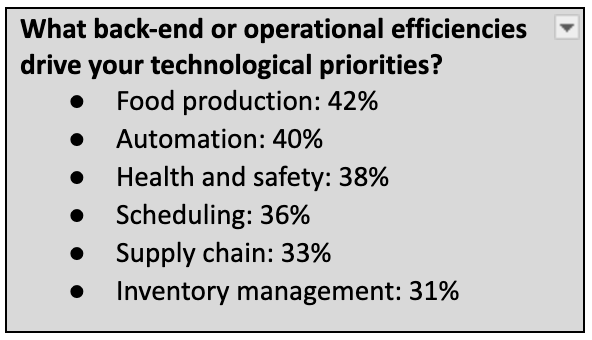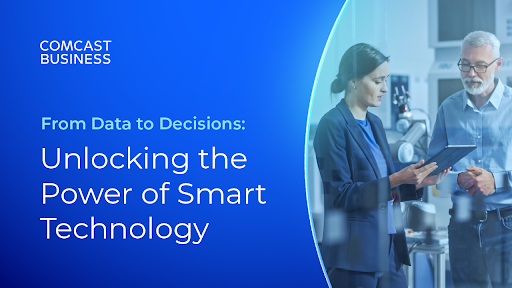Food & Bev Industry Turning to Tech to Improve Back-end Operations

The restaurant industry has often been required to operate on tight profit margins, roughly 3% - 9% depending on the type of restaurant. Throw in a global pandemic and operating in the black can be even more difficult. But technology is proving to be a major efficiency tool for many restaurants, as it plays a leading role in improving back-end operations.
Demand Science recently conducted a survey in collaboration with Comcast Business of more than 200 IT executives within the food and beverage industry. The survey found 30% or more of respondents expect technology to play a role in back-end or operational priorities including food production, automation, health and safety, scheduling, and more.

Internet of Things (IoT) technologies play an outsized role in the back-office tech, helping to drive efficiencies in applications such as remote temperature monitoring of refrigerators, fryolators, and more. Robotics is also playing a role in everything from frying wings to flipping burgers and making salads.
If all of this technology is to deliver the desired efficiencies, it requires a sound foundation on which to operate. That means a robust Wi-Fi network within the restaurant as well as reliable wide area network (WAN) connections to outside resources, increasingly taking advantage of software-defined WAN (SD-WAN) technology. And of course, the network and all applications must be powered with ample bandwidth and protected with sound security measures.
Food production technology
Some of the most exciting technological advancements in the food and beverage market are on the food production front, where robots are taking on all sorts of jobs. Beverage delivery services are testing out robots and quick serve restaurants are testing robotic systems for cooking food. Some restaurants are automating the entire food preparation cycle, such as with a robotic system that prepares salads and warm protein bowls as they travel on a conveyor belt. The system, based on technology born at the Massachusetts Institute of Technology, cooks proteins and vegetables and steams pasta, noodles and grains before arranging everything just so in the bowl.
For any robotic systems to work reliably, the bots need high speed, low latency connections to the in-store controllers that are driving the action – highlighting the need for reliable in-store networks.
Automation
In terms of automation, employee management is one area that’s becoming more automated. It comes at a time when efficiency is important given nearly all restaurants are struggling with staffing. To help compensate, restaurants are turning to applications – often cloud-based – that can help them automate employee scheduling as well as operations tasks that run the gamut from food safety to maintenance.
Restaurants are also still relying on takeout and delivery to help keep profits up. Paying hefty fees to third-party delivery services and online ordering platform providers doesn’t help, so some are using tools that enable them to build their own food ordering platforms. The platforms come complete with marketing automation functions, loyalty programs and analytics to help drive personalization and order suggestions.
IoT systems can be used to monitor and automate energy systems to reduce costs. According to the website Modern Website Management, restaurants use $12-worth of energy per square foot, compared to $2 for a typical office building. IoT-based energy management systems can help reduce those costs by optimizing heating and cooling systems, including continually adjusting air handling units for efficient airflow. They can also automatically adjust temperatures to reduce energy consumption during off hours.
Health and safety
Automation tools also extend to issues that relate to health and safety, such as maintaining the optimal temperature in restaurant refrigerators to prevent food spoilage, which also helps with profit margins. Less and less will employees manually check and record refrigerator temperatures. Today, IoT sensors can continually track refrigerator temperatures and alert managers should the temp fall outside the optimal range.
Similarly, restaurants are now using mobile apps and digital checklists to track food safety audits, rather than keeping paper records. An FDA Hazard Analysis Critical Control Point (HACCP)-compliant digital checklist system helps restaurants keep all of their checklists in one place. It includes automatic timestamps to note when relevant events occur and enables restaurants to analyze historical trends to bubble up systemic problems.
IoT systems can even be employed to monitor restaurant production equipment, such as fryers, to ensure oil stays at the optimum temperature. They can also be controlled remotely, so a manager could turn on a fryer before arriving on site, to ensure it’s at the proper temperature come opening time.
Supply chain
The pandemic has dramatically altered supply chains around the globe, and food is no exception. More than ever, restaurants need powerful analytics tools and automated processes to help them ensure a steady stream of product. That may include inventory management systems that help better predict optimal ordering times and reduce food costs.
Supply chain technology that provides insight into surpluses, short supplies and delays can help restaurants navigate uncertain waters and ensure they have the ingredients they need to keep customers happy.
Built on a sound tech foundation
All of these emerging applications and solutions require restaurants to have sound IT infrastructure in place. Legacy networks based on older IT architectures may fall short of meeting the demands of emerging technologies.
Robust WiFi networks are a must throughout the restaurant. Besides meeting guest expectations, fast, reliable WiFi networks are required in the back end of the restaurant, to meet demands of latency sensitive technology such as robotics and IoT monitoring solutions.
As restaurants increasingly adopt cloud-based solutions, they will also need a sound WAN strategy. Chains with multiple locations may find SD-WAN makes good sense. With SD-WAN, network control functions are abstracted from the underlying physical network. This enables restaurants to choose the WAN service that matches the requirements of each application and location while also improving reliability. Configuring backup links for each connection becomes a simpler task, such as using Internet or cellular wireless connections, including emerging 5G services, to back up primary links.
Cybersecurity services are also a must, as no business today is immune from threats from phishing attacks, malware, ransomware and more.
Comcast Business
Create a differentiated dining experience and enhance systems performance with innovative technologies from Comcast Business. Learn more at business.comcast.com/restaurants-food-services
IoT is playing an increasing efficiency role for restaurants
Locked Content
Click on the button below to get access
Unlock NowOr sign in to access all content on Comcast Business Community
Resource Center
Learn how Comcast Business can help
keep you ready for what's next.










